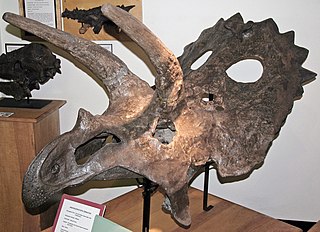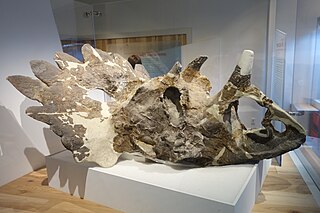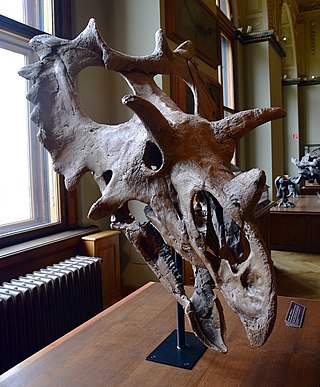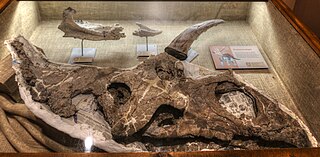
Torosaurus is a genus of herbivorous chasmosaurine ceratopsian dinosaur that lived during the late Maastrichtian age of the Late Cretaceous period, between 68 and 66 million years ago, though it is possible that the species range might extend to as far back as 69 million years ago. Fossils have been discovered across the Western Interior of North America, from as far north as Saskatchewan to as far south as Texas.

Chasmosaurus is a genus of ceratopsid dinosaur from the Late Cretaceous Period in North America. Its given name means 'opening lizard', referring to the large openings (fenestrae) in its frill. With a length of 4.3–4.8 metres (14.1–15.7 ft) and a weight of 1.5–2 tonnes —or anywhere from 2,200 to nearly 5,000 lbs., give or take—Chasmosaurus was of a slightly smaller to ‘average’ size, especially when compared to larger ceratopsians. The Chasmosaurs were similar, in overall build and weight, to a white rhinoceros or an Indian rhinoceros; just like rhinos, and all other ceratopsians, they were purely herbivorous, needing to consume around 54 kilograms, or 120 lbs., of plant matter each day.

Pentaceratops is a genus of herbivorous ceratopsid dinosaur from the late Cretaceous Period of what is now North America. Fossils of this animal were first discovered in 1921, but the genus was named in 1923 when its type species, Pentaceratops sternbergii, was described. Pentaceratops lived around 76–73 million years ago, its remains having been mostly found in the Kirtland Formation in the San Juan Basin in New Mexico. About a dozen skulls and skeletons have been uncovered, so anatomical understanding of Pentaceratops is fairly complete. One exceptionally large specimen later became its own genus, Titanoceratops, due to its more derived morphology, similarities to Triceratops, and lack of unique characteristics shared with Pentaceratops.

Anchiceratops is an extinct genus of chasmosaurine ceratopsid dinosaur that lived approximately 72 to 71 million years ago during the latter part of the Cretaceous Period in what is now Alberta, Canada. Anchiceratops was a medium-sized, heavily built, ground-dwelling, quadrupedal herbivore that could grow up to an estimated 4.3 metres (14 ft) long. Its skull featured two long brow horns and a short horn on the nose. The skull frill was elongated and rectangular, its edges adorned by coarse triangular projections. About a dozen skulls of the genus have been found.

Nodocephalosaurus is a monospecific genus of ankylosaurid dinosaur from New Mexico that lived during the Late Cretaceous in what is now the De-na-zin member of the Kirtland Formation. The type and only species, Nodocephalosaurus kirtlandensis, is known only from a partial skull. It was named in 1999 by Robert M. Sullivan. Nodocephalosaurus has an estimated length of 4.5 metres and weight of 1.5 tonnes. It is closely related and shares similar cranial anatomy to Akainacephalus.

Medusaceratops is an extinct genus of centrosaurine ceratopsian dinosaur known from the Late Cretaceous Judith River Formation of Montana, northern United States. It contains a single species, Medusaceratops lokii.

Chasmosaurinae is a subfamily of ceratopsid dinosaurs. They were one of the most successful groups of herbivores of their time. Chasmosaurines appeared in the early Campanian, and became extinct, along with all other non-avian dinosaurs, during the Cretaceous–Paleogene extinction event. Broadly, the most distinguishing features of chasmosaurines are prominent brow horns and long frills lacking long spines; centrosaurines generally had short brow horns and relatively shorter frills, and often had long spines projecting from their frills.

Kosmoceratops is a genus of ceratopsid dinosaur that lived in North America about 76–75.9 million years ago during the Late Cretaceous period. Specimens were discovered in Utah in the Kaiparowits Formation of the Grand Staircase–Escalante National Monument in 2006 and 2007, including an adult skull and postcranial skeleton and partial subadults. In 2010, the adult was made the holotype of the new genus and species Kosmoceratops richardsoni; the generic name means "ornate horned face", and the specific name honors Scott Richardson, who found the specimens. The find was part of a spate of ceratopsian discoveries in the early 21st century, and Kosmoceratops was considered significant due to its elaborate skull ornamentation.

Vagaceratops is a genus of herbivorous ceratopsian dinosaur. It is a chasmosaurine ceratopsian which lived during the Late Cretaceous period in what is now Alberta. Its fossils have been recovered from the Upper Dinosaur Park Formation. It is sometimes included in the genus Chasmosaurus as Chasmosaurus irvinensis instead of being recognized as its own genus.

Titanoceratops is a controversial genus of herbivorous ceratopsian dinosaur. It was a giant chasmosaurine ceratopsian that lived in the Late Cretaceous period in what is now New Mexico. Titanoceratops was named for its large size, being one of the largest known horned dinosaurs and the type species was named T. ouranos, after Uranus (Ouranos), the father of the Greek titans. It was named in 2011 by Nicholas R. Longrich for a specimen previously referred to Pentaceratops. Longrich believed that unique features found in the skull reveal it to have been a close relative of Triceratops, classified within the subgroup Triceratopsini. However, other researchers have expressed skepticism, and believe "Titanoceratops" to simply be an unusually large, old specimen of Pentaceratops.

Ahshislepelta is a monospecific genus of ankylosaur dinosaur from New Mexico that lived during the Late Cretaceous in what is now the Hunter Wash Member of the Kirtland Formation. The type and only species, Ahshislepelta minor, is known only from an incomplete postcranial skeleton of a small subadult or adult individual. It was named in 2011 by Michael Burns and Robert M. Sullivan. Based on the size of the humerus, Ahshislepelta is larger than Pinacosaurus mephistocephalus but smaller than Talarurus and Pinacosaurus grangeri.

Nasutoceratops is genus of ceratopsid dinosaur that lived in North America during the Late Cretaceous period, about 76.0–75.5 million years ago. The first known specimens were discovered in Utah in the Kaiparowits Formation of the Grand Staircase–Escalante National Monument (GSENM) from 2006 onwards, including a subadult skull with a partial postcranial skeleton and rare skin impressions and two other partial skulls. In 2013, the subadult was made the holotype of the new genus and species Nasutoceratops titusi; the generic name means "large-nosed horned face", and the specific name honors the paleotologist Alan L. Titus for his work at the GSENM. The dinosaur was noted for its large nose in news reports, and later featured in Jurassic World films.

Coronosaurus is a genus of centrosaurine ceratopsian dinosaurs which lived in the Late Cretaceous, in the middle Campanian stage. Its remains, two bone beds, were discovered by Phillip J. Currie in the Oldman Formation of Alberta, Canada, and its type and only species, Coronosaurus brinkmani, was first described in 2005, as a new species within the genus Centrosaurus. Later studies questioned the presence of a direct relationship, and in 2012 it was named as a separate genus. Coronosaurus means "crowned lizard", coming from "corona", Latin for crown, and "sauros", Greek for lizard; this name refers to the unique, crown-like shape of the horns on the top of its frill.

Judiceratops is an extinct horned dinosaur. It lived around 78 million years ago, during the Late Cretaceous Period in what is now Montana, United States. Like other horned dinosaurs, Judiceratops was a large, quadrupedal herbivore. It is the oldest known chasmosaurine.

Bravoceratops is a genus of large chasmosaurine ceratopsid dinosaur that lived approximately 70 million years ago, and is known from the Late Cretaceous Javelina Formation in what is now Texas, United States.

Regaliceratops is a monospecific genus of chasmosaurine ceratopsid dinosaur from Alberta, Canada that lived during the Late Cretaceous in what is now the St. Mary River Formation. The type and only species, Regaliceratops peterhewsi, is known only from an adult individual with a nearly complete skull lacking the lower jaw, which was nicknamed "Hellboy". Regaliceratops was named in 2015 by Caleb M. Brown and Donald M. Henderson. Regaliceratops has an estimated length of 5 metres (16 ft) and body mass of 2 metric tons. The skull of Regaliceratops displays features more similar to centrosaurines, which suggests convergent evolution in display morphology in ceratopsids.

Wendiceratops is a genus of herbivorous centrosaurine ceratopsian dinosaur from the Late Cretaceous of Canada.

Spiclypeus is an extinct genus of chasmosaurine ceratopsian dinosaur known from the Late Cretaceous Judith River Formation of Montana, United States.

Navajoceratops is a genus of ceratopsid dinosaur from the late Cretaceous Period of what is now North America. The genus contains a single species, N. sullivani, named after Robert M. Sullivan, leader of the expeditions that recovered the holotype.

Bisticeratops is a genus of chasmosaurine ceratopsian from outcrops of the Campanian age Kirtland Formation found in the Bisti/De-Na-Zin Wilderness in northwestern New Mexico, United States. The type and only species is B. froeseorum, known from a nearly complete skull.





























